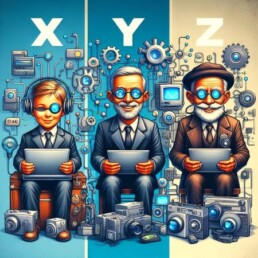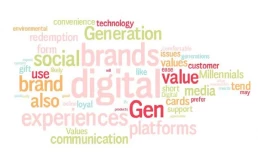Every good marketer gets that consumer behaviour can vary significantly between generations – particularly so with Gen Z. We investigate how the generations see rewards and incentives, given that intergenerational differences have never been more apparent.
As our CEO Denis Hure was discussing this very topic at the Loyalty Summit in Washington DC last week, we thought that it might help to summarise some of the key differences between Generation Z – born from the mid-to-late 1990s through the early 2010s), Generation Y, also known as Millennials, who were born from the early 1980s to the mid-to-late 1990s and Generation X (born from the early-to-mid 1960s to the early 1980s).
In short, a kind of marketer’s intergenerational cheat sheet.

Technology Use
When looking at how generations see rewards and incentives, let’s start with their attitude to technology. Gen Z, are digital natives, they’ve grown up with technology and the internet and as such are likely to use smartphones for virtually everything, from shopping to communication. This generation typically consumes a lot of short-form content on platforms like TikTok and Instagram.
Gen Y (Millennials) witnessed the rise and development of the internet, social media, and mobile technologies, adapting them into their lives along the way. They’re also tech-savvy, but they experienced life pre-internet, giving them a unique perspective on both digital and non-digital experiences. They are happy to consume both short-form and long-form content and use a mixture of social media platforms.
While Generation X can be described as generally quite tech-savvy and who also use technology for various purposes, their adoption came at a later stage in life. They’re often considered the “hybrid” generation — comfortable with both online and offline channels. Some Gen X still prefer to shop in-store compared to online, even though they’re familiar with both. Things like scams and viruses tend to have made some of the older cohort more wary of online activity.
Communication
Gen Z prefers quick and efficient communication. They tend to favour brands that communicate directly and honestly, and they expect swift responses to queries. They often interact with brands through social media platforms.
Millennials also appreciate brands that communicate honestly and transparently, but they may differ in their preferred platforms. They tend to use a mix of social media and email, while Gen Z often leans towards rapid, image-heavy communication on platforms like Instagram, Snapchat, and TikTok.
Many Gen X, however, rely on the more traditional forms of communication such as email or voice calls, albeit often initiated over platforms like Skype and WhatsApp. They tend to value and expect more thorough and detailed information from vendors and brands and will source news information from more traditional media channels.
Values and Motivations
Not surprisingly this is an area where there has been a steady evolution between generations, particularly around environmental issues.
Millennials were the forerunners in valuing businesses that prioritize sustainability and social responsibility. They’re motivated by experiences and prefer to spend money on these rather than tangible products. They are also known for being health-conscious and value work-life balance highly. They are the also the leading cohort in the WFH phenomenon.
Gen Z place a significant emphasis on social justice, inclusivity, and environmental responsibility. These values influence their purchasing decisions and behaviour, and they tend to support brands that take a stand on issues they care strongly about. For example, they’re more likely to engage with digital activism, using social media platforms to learn about, support, and spread awareness for these causes. Price and convenience are also important but rarely at the expense of their values.
While Gen X also care about these issues, they might prioritize practicality, convenience, and value for money. While not as frequently associated with environmental activism as the younger generations, many Gen X members are also engaged with these issues. Some may be involved in environmental lobby groups, but their activism may also take the form of support through donations or influencing corporate practices in their professional roles.
An important point to note is that they are motivated by security, and reliability and prefer products that offer durability and longevity – in other words, they want value for money not a quick fix.

Brand Loyalty
Lastly, a topic dear to the hearts of anyone involved in the rewards and incentives industry: how do these Generations compare when it comes to Brand Loyalty?
Gen Z tend to be less brand loyal compared to previous generations, as they have access to a wide variety of options and are often driven by trends. They value authenticity, diversity, and inclusivity, and tend to support brands that stand for causes they believe in, as outlined above.
While Gen Y (Millennials) are known to switch brands, they are more likely than Gen Z to show loyalty if they feel that the brand shares their values and provides exceptional customer experiences. They were the first generation to value experiences over things, which influences their brand preferences.
Historically, Gen X has been viewed as being more brand loyal. Traditionally, once they find a brand they like, they’re more likely to stick with it. They value quality and service, are willing to pay more for long-lasting, durable products, and companies that respect their time and adequately reward their loyalty. However, they have felt unfairly treated by some sectors such as banking where their loyalty has been presumed rather than properly rewarded by some well-established brands.
Summary of Preferences

Gen Z
- Primarily use smartphones for all digital activities
- Prefers short-form content on social media platforms
- Less brand loyal
- Prioritizes authenticity and supports brands that stand for causes they believe in
- Prefers quick, visual-based communication with the use of emojis, memes, and short videos
- Expects brand interaction on social media platforms
- Emphasis on social justice, inclusivity, and environmental responsibility
- Supports brands that align with their values

Gen Y (Millennials)
- Adaptable to new technology
- Uses a mix of devices and consumes both short-form and long-form content
- Loyal if brands share their values and provide excellent customer experiences
- Prioritizes experiences over material goods
- Prefers authentic, personalized digital communication
- Interacts with brands more interactively
- Values sustainability, social responsibility, and experiences
- Health-conscious and values work-life balance.

Gen X
- Comfortable with both digital and non-digital channels
- Prefers face-to-face communication for important discussions
- More brand loyal. Values quality, durability, and good customer service
- More likely to prefer direct communication from brands via email or direct mail.
- Values personal interaction and customer service.
- Values practicality, convenience, and security.
- Prioritizes products that offer durability and longevity.
Attitude to Rewards and Incentives
A further question that springs to mind is how these groups respond to rewards and incentives. While this is a bigger topic, which we will probably explore in a later post, to keep it simple let’s take a quick look at their relative attitudes towards digital gift cards as an example of prevailing attitudes.
””How do you feel about gift cards as a reward?”
”Digital gift cards? Yeah, they work for me. I like how they blend into the digital lifestyle. No clutter, easy to redeem, especially for my favourite brands. It’s a neat way to reward me, and it shows that the company is keeping up with the times.”
”Digital gift cards, huh? Well, they’re practical, I’ll give you that. It’s nice to not have another physical card to keep track of. But I do hope the redemption process is simple and there’s good customer support if I run into issues.”
“Oh, cool! Digital gift cards are super convenient, you know? I don’t have to worry about losing them, plus I can use them online instantly. And if it’s for a brand or experience I love, even better! Just makes sure it’s easy to add to my mobile wallet.”
Key takeaways on how Generations see rewards and incentives
- While it is logical to ensure that the reward category broadly appeals to the targeted demographic there are nuances in the mode and ease of redemption and delivery which need to be addressed.
- Both your own brand identity and that of the rewards offered, where branded, will need to appeal to the sensitivities of the individual generations being targeted. Maybe there is a case for brand-neutral rewards to keep costs down.
- Any communications regarding rewards and incentives should use appropriate channels, mode of address, and tone of voice.
If you are considering how to adapt your loyalty rewards program or employee rewards program to the specific needs of Generations X, Y, or Z , and just want to discuss how Generations see rewards and incentives, why not schedule a call with us now
